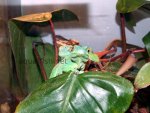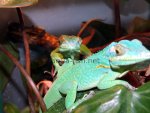Knight Anole (Anolis equestris) – Complete Care, Feeding, and Habitat Guide
Quick links
🦎 About This Guide
While aqua-fish.net is primarily dedicated to aquariums and fishkeeping, we also recognize that many aquarists are passionate about other exotic pets. This page offers a comprehensive care guide for one of the most striking lizards kept in captivity—the Knight Anole (Anolis equestris).
Whether you're a reptile enthusiast or a curious beginner expanding beyond aquatic life, you'll find everything you need to know about housing, feeding, and breeding these impressive green giants.
💬 Have personal experience with Knight Anoles? Share your insights or questions at the bottom of the page—your input helps others provide better care!
📋 Knight Anole at a Glance
- Scientific name: Anolis equestris
- Common names: Knight Anole, Cuban Knight Anole
- Adult size: Up to 48 cm (19 inches)
- Lifespan: 6–8 years
- Native to: Cuba (established population in Florida)
- Enclosure size: Minimum 30 US gallons (≈ 115 litres), tall/vertical design recommended
- Difficulty level: Intermediate to advanced
🦎 Introduction to the Knight Anole (Anolis equestris)
Anolis equestris, commonly known as the Knight Anole or Cuban Knight Anole, has become an increasingly popular reptile pet in recent years. However, it’s important to note that this species is not suitable for beginners. Knight Anoles are known for their low tolerance of handling and may bite if stressed or provoked. For this reason, they are best suited for experienced reptile keepers.
Despite their temperament, Knight Anoles are visually stunning lizards. Their striking green coloration, alert eyes, and distinct markings make them a favorite among hobbyists who value natural beauty and species diversity.
🌍 Origin and Distribution
The Knight Anole originates from Cuba, which is why the name "Cuban Knight Anole" is often used. Over time, some individuals were illegally smuggled into Florida, leading to the establishment of a wild population in certain areas. As a result, the smuggling of this species has significantly declined due to their new availability.
📏 Size, Space Requirements, and Physical Traits
Knight Anoles are among the largest members of the Anole genus, with adults reaching up to 19 inches (48 cm) in total length. Due to their size, they require a spacious enclosure—at least 30 gallons (≈ 115 litres) is considered the minimum for a single adult.
Taxonomically, the species belongs to the family Polychrotidae and is classified within the order Squamata, suborder Iguania.
Physically, Knight Anoles have a long, narrow snout and a serrated tail, which helps with balance. Their toe pads act like suction cups, allowing them to climb vertical surfaces with ease. Each toe also has a claw, enabling them to grip branches and other surfaces. These claws can be used for defense, so it’s essential to handle them with care and respect.
Because of their aggressive territorial behavior, it is highly discouraged to keep multiple Knight Anoles in the same terrarium. Housing them together often leads to conflict and stress, particularly among males. Keeping a single specimen is recommended for easier care and peace of mind.
🎨 Coloration and Texture
Knight Anoles are typically a vivid green, although their coloration can shift depending on mood or environmental factors. They often display a yellow or white stripe on both sides of the head, starting below the eyes and running toward the shoulders.
Their skin has a rough, textured surface, giving them a unique, slightly bumpy feel to the touch. This adds to their exotic appearance and reinforces their wild origins.
🏡 Caring for Your Knight Anole
📏 Enclosure Size and Setup
Knight Anoles require a spacious vertical enclosure due to their climbing nature and overall size. Use a tank of at least 30 gallons (≈ 115 litres) for a single adult. Provide plenty of branches or vines to climb, and add a suitable substrate at the bottom.
Lighting is important—use a vivarium that allows natural light or install lighting panels. While some keepers modify aquariums, others prefer wooden vivariums with glass fronts. Avoid shallow tanks; the higher the enclosure, the better.
🌡️ Temperature and Heating
Maintain daytime temperatures between 26°C – 32°C (80°F – 90°F). At night, it’s acceptable to lower the temperature slightly, but avoid letting it drop too far. Low temperatures may slow the lizard’s metabolism, causing it to stop eating and become inactive.
Heat can be provided using various methods. While heat mats are an option, they may not be the most efficient. More reliable are thermostatically controlled heaters or basking spot lamps, which turn off automatically once the desired temperature is reached.
☀️ UV Lighting Requirements
UVB light is essential for the health of your Knight Anole. Install a basking lamp inside the enclosure, ensuring the lizard can get within 30 cm (1 foot) of the bulb. Keep the lamp on for at least 10–12 hours daily to simulate a natural light cycle and support calcium absorption.
🌿 Hiding Places and Enrichment
Just like humans, lizards need privacy. Provide hiding spots using items like sideways plant pots or commercially available reptile hides. These allow your lizard to escape and feel secure when needed.
💧 Water and Humidity
Place a shallow water bowl in the enclosure. To ensure long-term health, maintain humidity levels around 65% or higher. Misting systems or hand misters help by simulating natural rain and hydrating foliage, which Anoles drink from directly.
🧹 Substrate and Cleaning
Substrate choices include sphagnum moss or commercial reptile bedding. Although a bare bottom may simplify cleaning, it may also cause heat to escape if heat mats are used. Clean the vivarium regularly, including water bowls and hiding areas, to prevent bacterial growth or disease.
🚫 Aggression and Housing Companions
Never house two male Knight Anoles together; they will fight, often to the death. Females may be introduced for breeding, but avoid keeping pairs together long term. Males can become aggressive and stress the female, so only pair them temporarily and monitor their interaction closely.
🍽️ Feeding the Knight Anole
🦗 Natural Diet and Feeding Habits
In the wild, Knight Anoles primarily feed on insects, but they are also known to consume small amounts of animal protein such as earthworms, the young of their own species, and even other small lizards. Their diet is highly carnivorous and opportunistic.
🏠 Feeding in Captivity
Feeding Knight Anoles in captivity is relatively straightforward, thanks to the wide availability of feeder insects. Common options include:
- Crickets
- Grasshoppers
- Small earthworms
To ensure proper nutrition, always dust feeder insects with calcium powder before offering them. Additionally, use the technique of gut loading, which involves feeding nutrient-rich food to the insects before they are consumed by your Anole. This boosts the vitamin and mineral content of the meal.
⚠️ Feeding Tips and Warnings
Avoid overfeeding. If you release live crickets or grasshoppers into the enclosure, your Knight Anole will eat at its own pace. Be sure to remove any uneaten or dead insects during regular cleaning to prevent hygiene issues.
🐣 Breeding Knight Anoles
🔍 Identifying Males and Females
Sexing Knight Anoles is relatively easy. Males are typically larger and possess a prominent pink throat fan (dewlap), which they extend during displays or when feeling threatened. Females may also have a dewlap, but it is usually smaller and less colorful.
🌡️ Breeding Season and Behavior
Breeding occurs during the warm summer months when temperatures are optimal. Anoles usually do not breed in cooler seasons. Introducing a female to the male's enclosure may initially trigger aggressive posturing, but this is often part of the courtship behavior.
If the male is interested, he will nod repeatedly and display his dewlap before gently grasping the female around the neck. He then positions his tail beneath hers to allow for mating.
⚠️ Common Issues During Mating
Male Anoles can occasionally attempt to mate with another male due to mistaken identity. Always supervise introductions and be prepared to separate them if needed.
After successful mating, the female typically lays one egg every two weeks. The eggs hatch in approximately 5–7 weeks, depending on temperature and humidity conditions.
🧠 Behavior and Activity
Knight Anoles are diurnal reptiles, meaning they are active during daylight hours. They are highly alert, territorial, and prefer perching high off the ground where they can observe their surroundings. Territorial displays such as head-bobbing and dewlap extension are common, especially in males.
They prefer solitude and become stressed if approached frequently. They may remain motionless when threatened, relying on camouflage, or attempt to bite or flee.
🌿 Suitable Plants for the Enclosure
Live plants provide humidity, cover, and enrichment. Ideal options include:
- Pothos (Epipremnum aureum) – hardy, fast-growing, easy to maintain
- Bromeliads – attractive and water-holding, perfect for humidity
- Ficus benjamina – climbing plant, needs occasional pruning
- Dracaena – decorative and safe for reptiles
🧪 Supplements and Health Maintenance
To prevent common health issues like metabolic bone disease (MBD), provide calcium with vitamin D3 at least twice a week and a reptile multivitamin once weekly. These supplements ensure proper bone and muscle development, especially when UVB exposure may vary seasonally.
⚠️ Important Notes on Safety and Handling
- Always wash your hands thoroughly after handling reptiles. Amphibians and lizards may secrete mild toxins through their skin.
- When stressed or handled, Knight Anoles may defecate as a defense mechanism.
- They are not domesticated animals and do not tolerate frequent handling. Biting or clawing can occur.
- Never house two males together—they are highly territorial and will fight, often fatally.
📝 Frequently Asked Questions (FAQ)
Can I handle my Knight Anole regularly?
Knight Anoles are not fond of handling. They can become stressed, may bite, or attempt to escape. Occasional short handling may be tolerated, but it’s best to enjoy them as a display species.
Do Knight Anoles change color?
Yes, their vivid green color may shift to darker shades depending on mood, temperature, or stress levels. This is normal and not necessarily a sign of illness.
Can I keep Knight Anoles in groups?
It is strongly advised to keep them alone. Males are extremely territorial and will fight. Female-male pairs are only recommended temporarily during monitored breeding periods.
How often should I mist their enclosure?
Misting should be done at least once daily to maintain humidity above 65%. Automated misting systems are ideal for consistency.
How long do Knight Anoles live?
With proper care, Knight Anoles can live between 6–8 years in captivity. Diet, habitat quality, and stress levels all impact lifespan.



